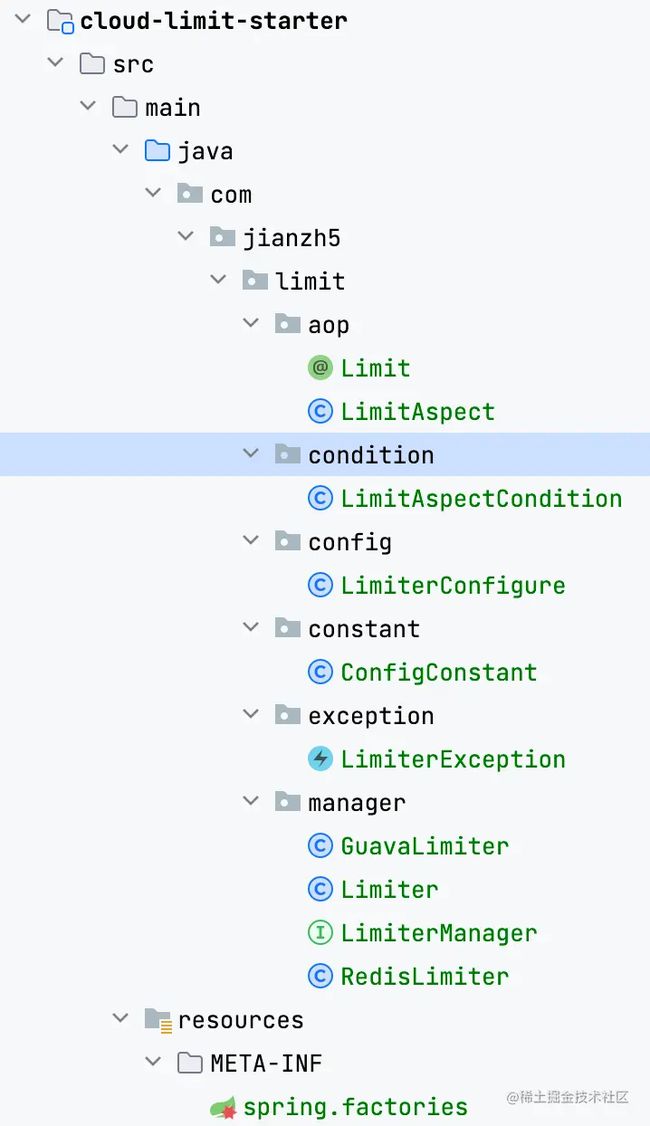SpringBoot中如何实现限流,这种方式才叫优雅。
现在,一个问题摆在我们面前:如何将这两种限流机制整合到同一个组件中,以便用户随时切换呢?
显然,我们需要定义一个通用的限流组件,将其引入到业务中,并支持通过配置文件自由切换不同的限流机制。举例而言,当使用limit.type=redis时,启用Redis分布式限流组件,当使用limit.type=local时,启用Guava限流组件。这种自由切换机制能够为用户提供更大的灵活性和可维护性。
接下来,让我们开始动手实现吧!
第一步,创建通用模块cloud-limiter-starter
首先在父项目下创建一个模块
然后在pom文件中引入相关依赖
com.google.guava
guava
org.springframework.boot
spring-boot-starter-web
provided
org.springframework.boot
spring-boot-starter-data-redis
provided
org.projectlombok
lombok
provided
org.springframework
spring-aspects
provided
复制代码小提示:通用模块命名最好遵照规则以starter命名结束,同时通用模块引入的依赖最好设置
属性。provided
第二步,实现限流功能
- 创建限流接口
既然有两种限流机制,按照套路肯定得先创建一个限流接口,就叫LimiterManager吧。
public interface LimiterManager {
boolean tryAccess(Limiter limiter);
}
复制代码- 分别实现Redis的限流功能和Guava的限流功能,这里只给出核心代码。
Guava限流的核心实现GuavaLimiter
@Slf4j
public class GuavaLimiter implements LimiterManager{
private final Map limiterMap = Maps.newConcurrentMap();
@Override
public boolean tryAccess(Limiter limiter) {
RateLimiter rateLimiter = getRateLimiter(limiter);
if (rateLimiter == null) {
return false;
}
boolean access = rateLimiter.tryAcquire(1,100, TimeUnit.MILLISECONDS);
log.info("{} access :{}",limiter.getKey() , access);
return access;
}
}
复制代码 Redis限流的核心实现RedisLimiter
@Slf4j
public class RedisLimiter implements LimiterManager{
private final StringRedisTemplate stringRedisTemplate;
public RedisLimiter(StringRedisTemplate stringRedisTemplate) {
this.stringRedisTemplate = stringRedisTemplate;
}
@Override
public boolean tryAccess(Limiter limiter) {
String key = limiter.getKey();
if (StringUtils.isEmpty(key)) {
throw new LimiterException( "redis limiter key cannot be null" );
}
List keys = new ArrayList<>();
keys.add( key );
int seconds = limiter.getSeconds();
int limitCount = limiter.getLimitNum();
String luaScript = buildLuaScript();
RedisScript redisScript = new DefaultRedisScript<>(luaScript, Long.class);
Long count = stringRedisTemplate.execute( redisScript, keys, "" + limitCount, "" + seconds );
log.info( "Access try count is {} for key={}", count, key );
return count != null && count != 0;
}
}
复制代码 第三步,创建配置类
编写配置类根据配置文件注入限流实现类,当配置文件中属性 limit.type=local 时启用Guava限流机制,当limit.type=redis 时启用Redis限流机制。
@Configuration
public class LimiterConfigure {
@Bean
@ConditionalOnProperty(name = "limit.type",havingValue = "local")
public LimiterManager guavaLimiter(){
return new GuavaLimiter();
}
@Bean
@ConditionalOnProperty(name = "limit.type",havingValue = "redis")
public LimiterManager redisLimiter(StringRedisTemplate stringRedisTemplate){
return new RedisLimiter(stringRedisTemplate);
}
}
复制代码第四步,创建AOP
根据前面的两篇文章可知,避免限流功能污染业务逻辑的最好方式是借助Spring AOP,所以很显然还得需要创建一个AOP。
@Aspect
@EnableAspectJAutoProxy(proxyTargetClass = true) //使用CGLIB代理
@Conditional(LimitAspectCondition.class)
public class LimitAspect {
@Setter(onMethod_ = @Autowired)
private LimiterManager limiterManager;
@Pointcut("@annotation(com.jianzh5.limit.aop.Limit)")
private void check() {
}
@Before("check()")
public void before(JoinPoint joinPoint){
MethodSignature signature = (MethodSignature) joinPoint.getSignature();
Method method = signature.getMethod();
Limit limit = method.getAnnotation(Limit.class);
if(limit != null){
Limiter limiter = Limiter.builder().limitNum(limit.limitNum())
.seconds(limit.seconds())
.key(limit.key()).build();
if(!limiterManager.tryAccess(limiter)){
throw new LimiterException( "There are currently many people , please try again later!" );
}
}
}
}
复制代码注意到类上我加了一行@Conditional(LimitAspectCondition.class),使用了自定义条件选择器,意思是只有当配置类中出现了limit.type属性时才会加载这个AOP。
public class LimitAspectCondition implements Condition {
@Override
public boolean matches(ConditionContext conditionContext, AnnotatedTypeMetadata annotatedTypeMetadata) {
//检查配置文件是否包含limit.type属性
return conditionContext.getEnvironment().containsProperty(ConfigConstant.LIMIT_TYPE);
}
}
复制代码第四步,创建spring.factories文件,引导SpringBoot加载配置类
## AutoConfiguration
org.springframework.boot.autoconfigure.EnableAutoConfiguration=\
com.jianzh5.limit.config.LimiterConfigure,\
com.jianzh5.limit.aop.LimitAspect
复制代码完整目录结构如下:
第五步,在项目中引用限流组件
- 引入依赖
com.jianzh5
cloud-limit-starter
复制代码- 在application.properties中设置加载的限流组件
limit.type = redis
复制代码如果不配置此属性则不加载对应限流功能。
- 在需要限流的接口上加上注解
@Limit(key = "Limiter:test",limitNum = 3,seconds = 1)
复制代码小结
通过上述步骤,我们已经成功实现了一个通用限流组件。在实际应用中,只需要根据场景需求选择对应的限流机制,即可非常方便的进行限流操作。这种灵活性和便捷性,也是SpringBoot中定义Starter的一般套路。

